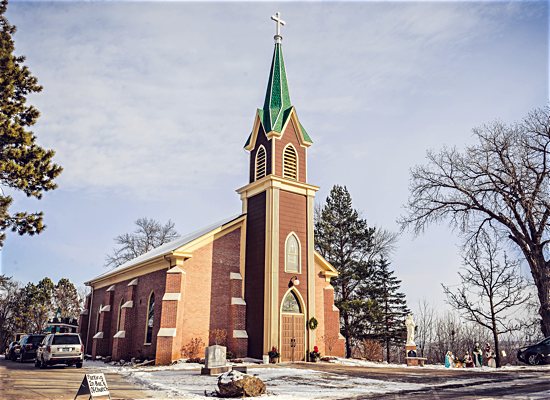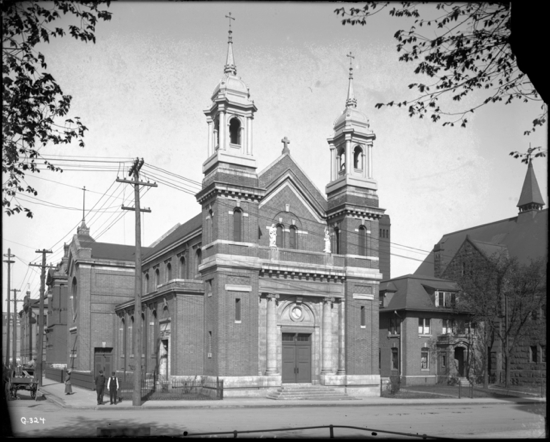
St. Nicholas
A church built by German farmers on the brow of a hill in Carver overlooking the Minnesota River will mark its 150th anniversary on the feast day of its patron saint — Dec. 6, St. Nicholas Day.
A congregation of 200 processed on St. Nicholas Day in 1868 from Carver’s Town Square to the dedication Mass for St. Nicholas Church at the top of the steep hill where it still stands today, in a community sustained over time by steamboat traffic, factory workers and housing developments.
And now, a congregation of about 850 people — including a growing Hispanic presence that makes up about half the parish — will celebrate the parish’s history of faith and service, said Jodee Korkowski, parish administrator.
“It’s that small, family feeling,” Korkowski said of the parish. “People know each other and are welcoming and supportive.”
St. Nicholas served as a refuge and symbol of hope for the people of Carver during a major flood in 1965. Earlier in its history, the parish became home to the area’s Catholic school when it moved from downtown Carver in 1876 to a new school on the parish’s eight-acre campus.
It grew to have 150 students taught by three Benedictine sisters, but closed in 1917.
The outside of the red-brick church, to which a wooden steeple was added in 1880, has largely remained the same over time. Renovations to the brickwork about four years ago were recognized by the city and state with preservation awards, Korkowski said.
Anniversary celebrations begin with Archbishop Bernard Hebda presiding at 4 p.m. Mass Dec. 1, followed by a reception and a historic memorabilia display. The celebration continues 8 a.m. to noon Dec. 2 with a pancake breakfast for people who attend the 9:15 a.m. Mass in English or the 10:30 a.m. Mass in Spanish.
Attendees can expect to see Jerry Riesgraf cooking sausages for the breakfast. A fifth-generation, lifelong member of the parish, Riesgraf also serves on the parish’s finance council.
“My ancestors were involved in building the church” and they received all their sacraments there, Riesgraf said, noting that the tradition has continued for himself and his children.
A third celebration will anticipate the feast of St. Nicholas itself, with a 6 p.m. Dec. 5 anticipatory Mass and a faith formation program for the parish’s youths. Jim Hammers, a member of Guardian Angels in nearby Chaska and a local historian, will present a history of St. Nicholas’ feast day and its celebration worldwide.
— Joe Ruff

St. Louis, King of France
In 1868, French-Canadian immigrants founded St. Louis, King of France in downtown St. Paul as a spiritual and cultural haven. Today, the “Little French Church” is still a place where many find respite in prayer, sacraments, concerts and French-inspired décor.
As the parish reflects on its history, it also is celebrating the faith, beauty and music that continue to radiate from the small church located on the busy intersection of 10th Street and Cedar Avenue.
The current church is the parish’s third. In 1868, a wood-frame church was built across the street from its current location by a mostly French-Canadian congregation. Its first bell was donated by Capt. Louis Robert, a riverboat owner and businessman after whom Robert Street was named, according to a parish history written by a former assistant pastor, Marist Father John Emerick, who died in 1993.
In 1881, the parish moved from its wood-frame church to a former Universalist church a block away. By the early 1900s, the congregation had outgrown that second church and hired the French emigrant Emmanuel Masqueray, architect of the Cathedral of St. Paul in St. Paul and Basilica of St. Mary in Minneapolis, who designed for them a brick and limestone Romanesque-style church. Construction was completed in 1909.
The parish had a school, “Ecole St. Louis,” from 1873 to 1963, when the area began to transition to high-rise offices and apartments. During that time, many of the parish’s families moved away, and new downtown dwellers became members.
“Often we get new parishioners, and they tell me that they’re new to the area and kind of shopping around for a parish,” said Father John Sajdak, a member of the Society of Mary, aka Marists, and pastor of the church, which seats 300. “They come to our church and they’re just overwhelmed with the beauty.”
The Marists have been entrusted with the parish since 1885. They offer ample confession opportunities — one of the parish’s hallmarks along with beautiful music, especially from the parish’s organ, donated in 2016 to replace one damaged in an arson fire in 1957.
“It’s an oasis of peace in music in downtown St. Paul,” said Marist Father Paul Morrissey, who served as the parish’s pastor for 28 years until 2016. The parish celebrated the anniversary Nov. 4 with Mass offered by Archbishop Bernard Hebda, followed by a gala dinner at the Town and Country Club in St. Paul.
— Susan Klemond



